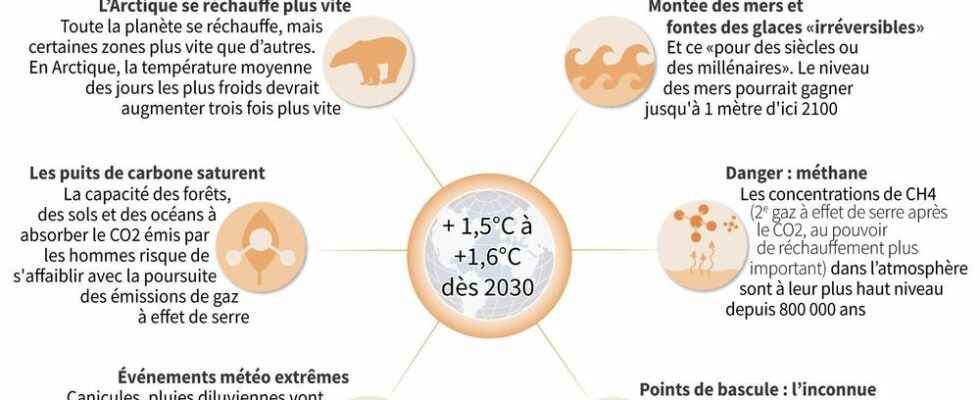The text paints a cataclysmic picture of the impacts on humanity of ever-accelerating climate change, despite repeated calls to drastically reduce greenhouse gas emissions. The second part of the sixth report of the IPCC (Intergovernmental Panel on Climate Change) published on Monday February 28 is the synthesis of years of research work on the effects of global warming and the way in which man and the living can adapt to it. The summary for decision-makers has just been validated word by word by 195 States after fifteen days of intense negotiations behind closed doors. More than 34,000 scientific articles are referenced in the report.
- Global warming is already a scourge, and it will get worse
Extreme heat, droughts, fires, cyclones, rising sea levels… “Human-induced climate change, including increased frequency and intensity of extreme events, has caused widespread negative impacts and losses and damages for nature and people, beyond the natural variability of the climate”, affirm from the outset the some 270 international scientists who contributed to the development of the UN report. The devastating consequences of climate change, long seen as a dash on the horizon, have now become a reality in every corner of the planet, with 3.3 to 3.6 billion people already “very vulnerable”, that is almost half of humanity.
Warming of about +1.1°C on average since the pre-industrial era has already contributed to the decline of species and the extinction of some, to the increase in diseases transmitted by mosquitoes, to more deaths caused by heat and drought, to a loss of agricultural and fisheries crops. People’s health, physical and mental, is also affected.
A selection of key points from the IPCC climate report
afp.com/Alain BOMMENEL
“The increase in meteorological and climatic extremes has led to irreversible impacts” on human societies and nature, concludes the IPCC. But this is only the beginning and the impacts on nature and humans will increase: possible extinction of 3 to 14% of terrestrial species at +1.5°C, “billions” of additional people exposed to dengue fever, or in general, a “significant increase in disease and premature death”.
- One billion people in coastal areas by 2050
Regardless of the rate of greenhouse gas emissions, a billion people could live by 2050 in coastal areas at risk, as rising sea levels heighten the impact of storms and flooding marines. The population at risk of sea flooding will double if the ocean rises 75cm, a figure broadly consistent with projections for 2100. Today, around 900 million people live less than 10m above sea level. from sea level.
By 2100, the value of infrastructure and other assets installed in these areas prone to exceptional (“one in 100 years”) floods will be around $10 trillion in a moderate emissions scenario.
- Temporarily exceed +1.5°C
The first part of the IPCC report on the physics of the climate in August had estimated that it would be possible, in the event of probable overrun of +1.5°C, the most ambitious objective of the Paris agreement, to then return under this threshold by the end of the century. But this even temporary overshoot, which climatologists call “overshot“, would not go without repercussions.
Anything over +1.5° would “lead to irreversible impacts” on key ecosystems like coral reefs, mountain glaciers and ice caps. “The risk of severe impacts increases with each additional fraction of warming,” temporary overshoot or not, the report said.
The previous report of 2007 did not expand on the issue of adaptation, ie the measures taken to limit or prepare for the impacts of global warming. This question is now central. In general, the IPCC warns that the world is not ready, warming is going faster than measures to adapt to the consequences. In addition, “at the current rate of planning and implementation of adaptation, the gap between needs and what is done will continue to grow”.
Rediscovery of old varieties of more resistant agricultural crops, restoration of mangroves or construction of dykes, planting trees in cities to create cooled corridors or air conditioning: the exploration of possibilities is urgent. But without guarantee of result.
The IPCC thus warns against the dangers of measures which can be totally counterproductive, when the world no longer has any margin for error. “There is growing evidence of maladaptation across many sectors and regions.”
The most optimistic scenario is in green, the most pessimistic in red. The Paris Agreement aims to limit global warming to below 2°C. The commitments so far made by the States – and which are not fully respected – would lead us to +3°C.
CNRS/IPCC
For example, building a dyke to protect against marine flooding caused by rising sea levels can lead to the development of the area in question, which is the most at risk, creating an erroneous sense of security.
- Waterfall and tipping points
The report highlights some irreversible and potentially catastrophic changes to the climate system, called “tipping points”, that can be triggered at certain levels of warming. This relates in particular to the melting of the Greenland and West Antarctic ice sheets which contain enough icy water to raise the oceans by 13m.
In the shorter term, certain regions – northeast of Brazil, Southeast Asia, the Mediterranean, central China – and the coasts almost everywhere could be hit by multiple disasters at the same time: drought, heat wave, cyclone, fires , floods. Science is just beginning to look at the impacts of these cascading impacts.
